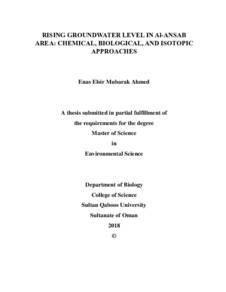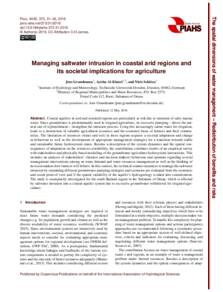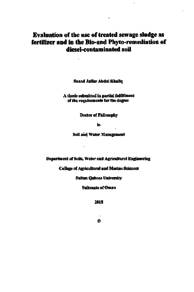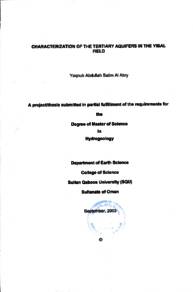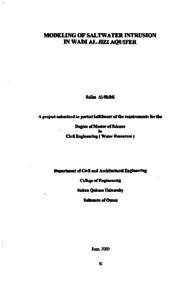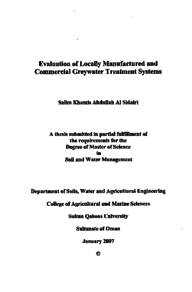Document
Rising groundwater level in Al-Ansab area : chemical, biological, and isotopic approaches
Publisher
Sultan Qaboos University
Gregorian
2018
Language
English
Subject
English abstract
The phenomenon of rising groundwater level is an international issue found in several urban areas including Al-Ansab area of Oman. Water appears on the surface and shallower excavations and has affected houses and buildings, posing health and environmental threats and calling for intervention. Therefore, the main objective of this study is to identify the possible water leak sources that cause the rise in groundwater level using chemical, biological and isotopic analyses. In this study, 20 water samples were collected in April / May 2017 and March 2018 field visits, while 19 water samples were collected in December 2017. The samples were collected from different sources including groundwater, surface water, drinking water network and Haya wetland water. The physical parameters of water samples (pH, TDS, EC) were measured in the field using portable probes AP-5000. Water alkalinity was found through titration whereas major cations and anions were measured using ICP-OES and IC, respectively. In addition, biological parameters composed of total coliform and E.coli were analyzed by using Eosine Methylene Blue Agar method (EMB) in April and May field visits and HiChrome Coliform Agar method in December and March. Moreover, isotopes deuterium (2H) and oxygen-18 (18O) were measured using Triple- Liquid Water Isotope Analyzer (T-LWIA). All groundwater samples show high Total Dissolved Solids (TDS) indicating interaction with the hosting rocks (limestones, dolomite, and gypsum). However, surface water samples have low TDS which may suggest mixing with drinking network water (DNW). Groundwater shows high concentrations of Mg2+ and Ca2+ ions due to the interaction of water with limestones and dolomites followed by high SO42- and Cl- concentrations driven from gypsum and halite (present in Aruma Formation), respectively. Saturation index estimated for Al-Ansab water indicates that groundwater precipitates calcite and dolomite due to oversaturation with Ca2+ and Mg2+ ions and can further dissolve. Biological tests of Al-Ansab water concluded that there is no sewage leak to Al-Ansab groundwater associated with septic tanks, but rare contamination presents on the surface from animals and surficial activities. Isotope analyses showed that causes of groundwater level rise are both anthropogenic and natural. The leak from DNW has affected localized areas, whereas rainfall along with impermeable subsurface geology has affected groundwater level rise in a regional scale. The presence of the impermeable units in the Aruma Formation and the mar units in the tertiary sediments has significantly impaired the downward gravity flow and retained water within the thinner overlying alluvium.
Description
Thesis
Member of
Resource URL
Arabic abstract
تعتبر ظاهرة ارتفاع المياه الجوفية من المشاكل العالمية المنتشرة في عدة مناطق ومن بينها منطقة الأنصب بسلطنةعمان . حيث أدت هذه الظاهرة إلى ظهور المياه على السطح وفي مناطق الأعمال الحفرية مما يشكل تهديداً للصحة والبيئة يستوجب التدخل. تهدف هذه الدراسة بشكل رئيسي لتحديد مصادر التسرب المحتملة التي تسهم في ارتفاع مناسيب المياه الجوفية وذلك بالإعتماد على التحاليل الكيميائية والبيولوجية والنظائر. واعتمدت هذه الدراسة على جمع20عينىة مياه من خلال الزيارات الميدانية في أبريل/ مايو 2017 و مارس 2018 في حين تم جمع 19 عينة ماء في ديسمبر 2017 من مصادر مختلفة وهي مياه الآباروالمياه السطحية وشبكات مياه الشرب ومياه بحيرات الأنصب التابعة لمنطقة حيا. واعتمدت الدراسة على تطبيق التحليلات الفيزيائية )الرقم الهيدروجيني ومجموع المواد الصلبة الذائبة والتوصيلة الكهربائية ( في منطقة الدراسة باستخدام جهاز فحص الماء AP-5000 ، كما تم تحديد قلوية الماء بطريقة المعايرة بالتحليل الكيمائي، أما الأيونات الموجبة والأيونات السالبة فتم تحليلها باستخدام التحليل الطيفي للانبعاث الذري البلازمي ICP-OES و IC على التوالي. من جهة أخرى تم اجراء التحليلات البيولوجية للكوليفورم والايكولاي )الاشريكية القولونية( باستخدام صبغة يوزين ميثيلين الأزرق (EMB) في شهري أبريل ومايو وطريقة الهايكوروم كوليفورم اجار في ديسمبر ومارس. بالاضافة الى ذلك تم استخدام جهاز تحليل نظير الماء السائل الثلاثي)LWIA-Tلتحليل الهيدروجين الثقيل ) H2 ( والأكسجين ) O18 (. وقد أبانت جميع نتائج المياه الجوفية ارتفاع في معدل المواد الصلبة الذائبة وهذا يدل على تفاعل هذه المياه مع صخور المنطقة الرئيسية ) الحجر الجيري والدولومايت والجبس( ، بينما اظهرت المياه السطحية انخفاض المواد الصلبة الذائبة وهذا يشير إلى وجود خلط لهذه المياه مع مياه شبكات الشرب. كما اظهرت الدراسة ارتفاع في معدلات المغنسيوم والكالسيوم مما يشير لتفاعل المياه مع الصخور الجيرية والدولومايت وارتفاع في معدلات الكلورايد الذي قد ينتج من التفاعل مع الصخر الملحي وارتفاع الكبريتات التي قد تنتج من التفاعل مع الجبس ، وتتواجد هذ الصخور في طبقة الأروما في منطقة الدراسة. كما أن الدراسة اشتملت على قياس درجة التشبع لمياه منطقة الأنصب والتي اظهرت التشبع الزائد للمياه بعنصري الكالسيوم والمغنسيوم مما احدث ترسيب لهما وقابلية لترسيب المزيد منهما. والخلاصة التي آلت لها التحليلات البيولوجية بمنطقة الأنصب هي عدم وجود تلوث ناتج عن تسرب مياه مجاري من خزانات الصرف الصحي إلى المياه الجوفية، مع قليل من التلوث في المياه السطحية الناتج من الحيوانات والأنشطة البشرية في السطح. واظهرت نتائج النظائر أن سبب ارتفاع منسوب المياه الجوفية في منطقة الأنصب هو مصادر طبيعية وأنشطة بشرية. كما أدى تسرب مياه الشرب، بالإضافة لمياه الأمطار والطبقة الجيولوجية إلى ارتفاع منسوب المياه الجوفية في المنطقة. وأشارت النتائج أيضا إلى تأثر المنطقة بوحدات غير منفذة للمياه في طبقة الأروما ووحدات المارل المتكونة من كربونات الكالسيوم في الطبقة الروسوبية والتي تضعف سريان المياه للأسفل مما يؤدي إلى الإحتفاظ بالمياه في طبقة الطمي.
Category
Theses and Dissertations

